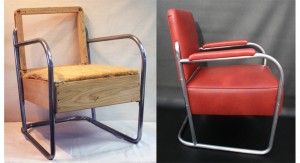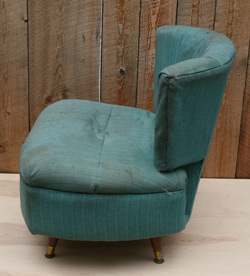“Is my sofa or chair worth restoring?”

Before & After: repairs on this Mid-century Club Chair include replacement of a split board & addition of a new bolt attachment to reinforce the frame
This is a question we hear often – in reference to vintage finds or family heirlooms. The answer is important because restoration is really an investment, whether you’re doing it yourself, or paying a professional to do it. You want to know that you are investing in something that will last.
Here’s my checklist for determining the potential of a piece of upholstered furniture.
- First and Foremost: How do you feel about it – whether that feeling comes from a memory, the pleasing shape, color, or style? Perhaps it recalls a certain era or person in your life.
- Metal frames may separate at weak points, and can usually be repaired with a tack-weld.
- Connecting hardware (screws and bolts) can be replaced and tightened anew.
- If it is a wood-frame antique, chances are the frame is hardwood and worthy of revitalization. Even if the joints are loose, they can be re-glued, and even broken parts may be easily repaired by a woodworker.
- If the age isn’t obvious, carefully remove one corner of the fabric covering the underside to check for solid wood framing. Particle board & chip board are not repairable once the material has been compromised.
- Parts that are compromised can be replaced with something stronger and more permanent. For example, a splintered dining seat platform that is not part of the supporting frame can be easily replaced with new wood.
- Springs that are broken or ‘every-which-way’ can be replaced or re-tied.
- Webbing or other platform material may be replaced.
- Stinky upholstery padding and fabric can be replaced – the old parable “you can’t judge a book by it’s cover” applies nicely here.

The solid construction of this “ugly duckling” holds great promise for rehabilitation
Join NaturalUpholstery.com’s mailing list to receive our monthly newsletter with reupholstery tips, creative inspiration, and resources for using natural, non-toxic materials for upholstery.
Leave A Comment